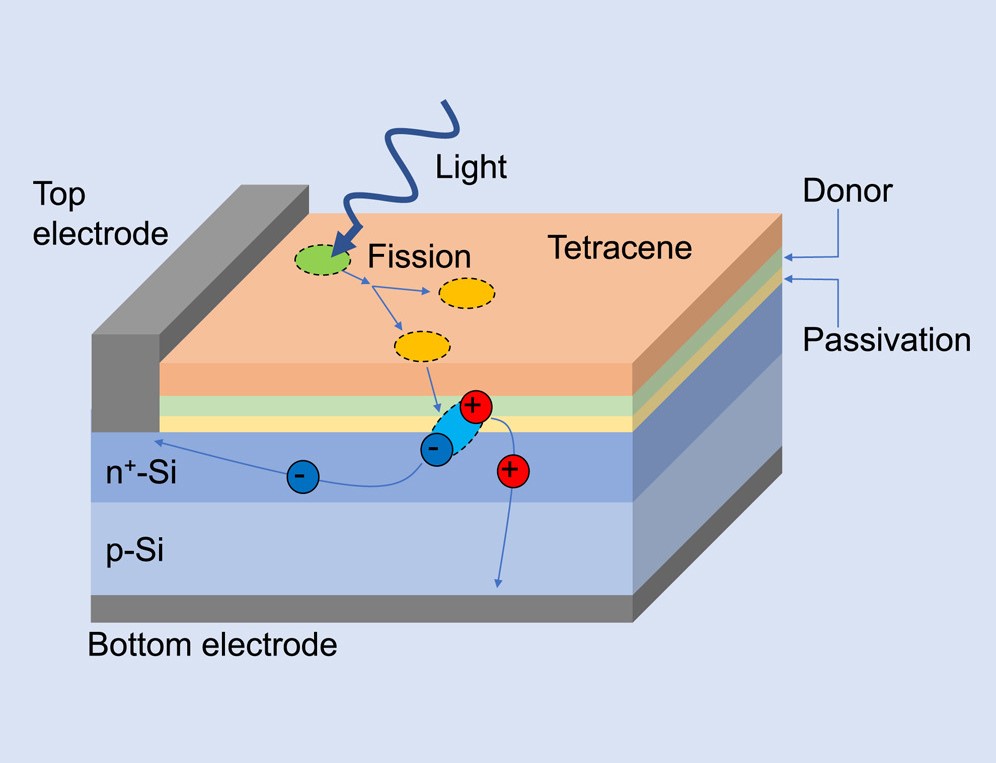Scientists in the United States have designed a microwire solar cell that could reportedly enable the coupling of singlet fission with silicon. Key to their achievement was an interface that transfers the electrons and holes sequentially into silicon instead of both at once.
May 28, 2025
From pv magazine Global
Working with an effect known as singlet exciton fission (SF), scientists from the Massachusetts Institute of Technology (MIT) have demonstrated a novel silicon solar cell concept that could potentially surpass the quantum efficiency limit for conventional PV devices.
Singlet exciton fission is an effect seen in certain materials whereby a single photon can generate two electron-hole pairs as it is absorbed into a solar cell rather than the usual one. The effect has been observed by scientists as far back as the 1970s and though it has become an important area of research for some of the world’s leading institutes over the past decade; translating the effect into a viable solar cell has proved complex.
Singlet fission solar cells can produce two electrons from one photon, making the cell more efficient. This happens through a quantum mechanical process where one singlet exciton (an electron-hole pair) is split into two triplet excitons.
“Up to now, we have only had indirect evidence that is possible to couple singlet exciton fission to silicon,” the research’s corresponding author, Marc A. Baldo, told pv magazine. “The breakthrough for us was to design an interface that transfers the electrons and holes sequentially into silicon instead of both at once.”
In the study “Exciton fission enhanced silicon solar cell,” which was recently published in Joule, the researchers explained that they designed and built a microwire (MW) cell with an interface based on a hafnium oxy-nitride (HfOxNy) film to improve the coupling between tetracene (Tc) and silicon. Tc and its derivatives are prime candidates for SF, as they can form charge transfer and multi-excitonic states.
The interface also included a thin aluminum oxide (AlOx) passivation layer that prevents the transferred charge carriers from immediately recombining at the silicon surface, as well as a zinc phthalocyanine (ZnPc) layer as an electron-donor material. “To minimize recombination on the rear side, a back surface field (BSF) layer with a junction depth of 1 μm and a localized back contact is added,” the scientists said. “A microgrid electrode is applied as the front electrode to efficiently collect carriers.”
In 2023, researchers from MIT and the University of Virginia announced plans to use acenes, which are benzene molecules with unique optoelectronic properties, in singlet fission solar cells. Their approach consisted of adding carbodicarbenes ligands to acenes that were already doped with boron and nitrogen.
In 2019, another MIT research group demonstrated how singlet exciton fission could be applied to silicon solar cells and could lead to cell efficiencies as high as 35%. They claimed to be the first group to transfer the effect from one of the ‘excitonic’ materials known to exhibit it, in that case also tetracene. They achieved the feat by placing an additional layer just a few atoms thick of hafnium oxynitride between the silicon solar cell and the excitonic tetracene layer.
The MIT researchers described their work as “turbocharging” silicon solar cells and said it differs from the most common approaches to increasing solar cell efficiencies, which these days are focused more on tandem cell concepts. “We’re adding more current into the silicon as opposed to making two cells,” they stated at the time.
This content is protected by copyright and may not be reused. If you want to cooperate with us and would like to reuse some of our content, please contact: editors@pv-magazine.com.
Popular content


